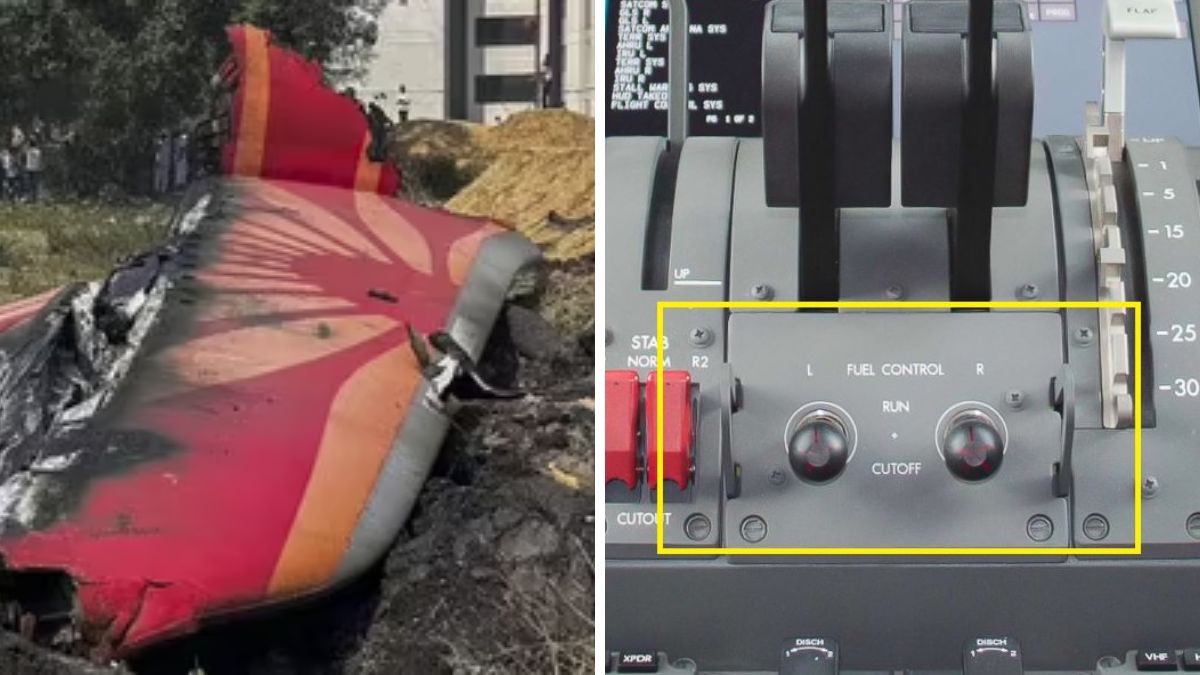Ahmedabad: A preliminary report into last month’s deadly Air India Flight 171 crash has sparked backlash from aviation experts and families of victims, after early findings pointed toward possible human error involving the aircraft’s fuel control switches.
The report by India’s Aircraft Accident Investigation Bureau (AAIB) indicates that both engine fuel control switches were moved from “RUN” to “CUTOFF” seconds after takeoff — a procedure that is supposed to be executed only once a plane is parked. The incident, which killed 241 passengers and at least 19 people on the ground, has raised concerns about whether pilot error, mechanical malfunction, or a failure in electronic systems was to blame.
“This exchange indicates that the engine shutdowns were uncommanded,” said Captain Amit Singh, founder of the Safety Matters Foundation. “However, the report does not identify the cause — whether it was crew error, mechanical malfunction, or electronic failure.”
The cockpit voice recorder captured one pilot asking the other why the engines were cut off — a question met with a denial. Investigators say the lack of clarity in this exchange underscores the need for full voice identification and additional cockpit data.
According to the Air India flight AI171 crash preliminary report,
This is what one of the pilots did just seconds after takeoff.
Is it possible? pic.twitter.com/2VBFcA5nNt
— Mohit Chauhan (@mohitlaws) July 12, 2025
Also Read: Minnesota Air Quality Alert: Canadian Wildfire Smoke Triggers Statewide Warning
Air India crash report reveals puzzling fuel switch movement
According to the AAIB’s Air India crash report, the Boeing 787-8 Dreamliner suffered total engine failure moments after taking off from Ahmedabad airport en route to London Gatwick on 12 June 2025. Both engines lost power shortly after the fuel control switches were moved to the “CUTOFF” position — a move that automatically shuts off fuel supply.
“The take-off was normal,” aviation analyst Terry Tozner told Sky News. “The aircraft rotated at the correct speed, left the ground, and almost immediately, the cut-off switches were selected to OFF — one, then two.”
The Ram Air Turbine (RAT), a backup emergency power device, deployed at roughly 60 feet above ground — suggesting the engines were already failing before official data recorded the failure.
Experts point out that fuel control switches are designed to be tamper-proof, requiring a locking mechanism to be manually disengaged before activation. While rare, a 2018 FAA bulletin had warned that some switches may have been installed without the locking feature engaged — making them susceptible to accidental shutdowns through vibration or contact.
“It would be almost impossible to pull both switches with a single movement of one hand,” an unnamed Canada-based air crash investigator told the BBC. “This makes accidental deployment unlikely.”
Where I unpack what the Air India Crash Report Reveals & What It Leaves Unsaid, as simply as I can. Let me know what you think and watch our indepth analysis here https://t.co/h6BC6ijiLD pic.twitter.com/IHpGPnEq3l
— barkha dutt (@BDUTT) July 12, 2025
Family members say report raises more questions than answers
The Air India crash investigation team includes experts from Boeing, General Electric, Indian regulators, and authorities from the UK and US. While mechanical failure has not been confirmed, the preliminary report has not issued safety directives to Boeing or the engine manufacturer as of now.
“What does this exactly mean?” asked Shawn Pruchnicki, a former airline accident investigator. “Could the switch just flip itself to OFF and shut down the engine? If that’s the case, it’s a really serious issue.”
Despite both pilots being highly experienced — with over 19,000 flying hours combined — critics say the Air India preliminary report appears to lean too quickly toward pilot error without ruling out potential technical or electronic system flaws.
“The report reads like a product description,” said Imtiyaz Ali, who lost four family members in the crash. “There’s nothing in it that really points to what caused the crash… At least give us some answers.”
India’s Civil Aviation Minister, Kinjarapu Ram Mohan Naidu, urged the public not to jump to conclusions. “We care for the wellbeing of our pilots. Let us wait for the final report,” he said.
Investigators call for cockpit video and deeper analysis
Multiple experts have echoed the need for cockpit video recorders — a long-standing recommendation by the NTSB that could have helped identify which pilot moved the switches.
“The new details suggest someone in the cockpit shut those valves,” said Peter Goelz, former MD of the NTSB. “The question is, who, and why?”
Investigators also found that the Emergency Locator Transmitter (ELT) did not activate after the crash, prompting new concerns over possible wiring, arming issues, or impact damage. Meanwhile, fuel contamination has been ruled out based on collected samples.
The aircraft’s landing gear was found in the down position, suggesting the crew had no time to retract it before attempting recovery — a detail confirmed by a senior 787 pilot who said the gear typically retracts by around 400 feet.
“When both engines fail at that altitude, you go numb,” the pilot told the BBC. “There’s no checklist — just a desperate attempt to control the descent.”
The final report is expected within a year, as investigators continue to examine voice data, maintenance records, and the cockpit’s electronic control systems.







